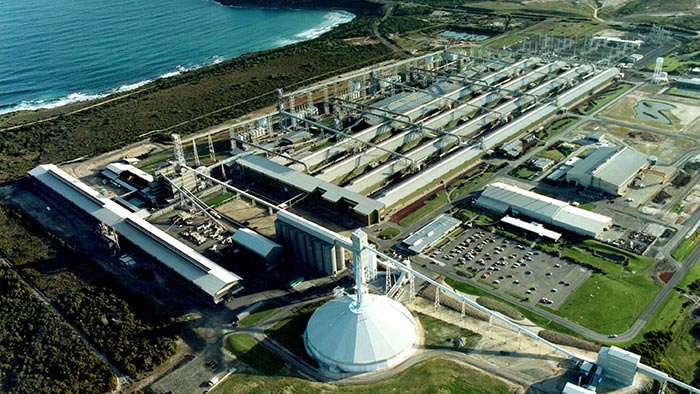

Portland Aluminium Smelter (Credit: Alcoa Australia)
The production of green aluminium, using supplies of low cost renewable energy, has already become cost competitive and will continue to become increasingly cheaper thanks to the falling costs of wind and solar, new analysis from BloombergNEF has detailed.
BloombergNEF’s analysis found that pairing aluminium smelting with sources of renewable electricity was already cost competitive in most parts of the world, and green aluminium will become increasingly cheaper compared to fossil fuel based production as renewable energy technology costs continue to fall.
The current average cost of producing aluminium using fossil fuels currently sits at US$1,680 per ton (A$2,156), while the combination of renewable energy sources and new “inert anode” technologies can already see production costs cut to just US$1,590 per ton (A$2,040), and avoiding virtually all emissions from the aluminium smelting process, BloombergNEF estimates.
The BloombergNEF report found that direct sourcing of zero emissions electricity from sources like wind and solar was the most cost effective way to produce green aluminium, with the costs of carbon capture and storage technologies continuing to be prohibitive.
Key to the low cost and low emissions aluminium is the wider adoption of ‘inert anodes’ in the smelting process, which can replace traditional ‘carbon’ anodes used in the electrolysis process, and help to avoid the release of carbon dioxide when aluminium is processed in smelters.
According to BloombergNEF, the ability for aluminium smelters to secure zero emissions and low cost supplies of clean energy through the use of power purchase agreements is making it possible for smelters to remain competitive while cutting emissions.
“Plummeting clean power costs are a boon for the aluminium industry. If producers can integrate more renewables into their supply, it will not only make the metal cleaner, but also cheaper,” lead author and metals analyst for BloombergNEF, Sharon Mustri, said.
“Aluminium smelters can become an asset to the electricity grid by using new technologies which will make them more flexible, and a linchpin for clean energy instead of coal. The key player in the industry is China – the country produces more than half of the world’s aluminium. If their smelters stop using coal, and re-power with renewables, global emissions for the sector will fall dramatically,”
BloombergNEF’s global head of industry and building decarbonization, Kobad Bhavnagri, told RenewEconomy that the assessment of green aluminium costs is also relevant to the Australian market, particularly due to the abundance of low cost wind and solar.
“The findings of this global report hold in Australia too,” he said.
“Renewable energy is already the cheapest source of electricity in Australia, and there are also well-developed PPA and derivative markets, that would readily enable an aluminium smelter to purchase 100% clean power ‘virtually’ now, before transitioning to 24/7 renewable supply in the years and decades ahead.
“Australia has a golden opportunity to establish itself as a major player in green aluminium, but we will need to move decisively. Australia has all the raw ingredients to become world leaders in green aluminium, but we need to set that goal and put in place a plan to get there. Re-tooling and modernizing our aluminium smelters with clean technology would create jobs, investment and new export opportunities.”
Bhavnagri said that the emergence of competitive production of green aluminium was an opportunity for Australia to establish itself as a leading global supplier of zero emissions materials and an economic “superpower” based on renewable energy sources.
“Australia is one of the best-placed countries on Earth to become a renewable energy superpower, that produces energy intensive goods with near-zero emissions for the world to consume. Many envision doing this by exporting renewable electricity through cables and hydrogen by ship.”
“But these are decades away. Aluminium is ready to go now. The technology exists to produce green aluminium today, and the economics have reached a tipping point. There is demand from major buyers like Audi and Apple, and dozens more. It’s up to us to innovate and serve this market, and capture the opportunities that global decarbonization presents.”
One of Australia’s last remaining aluminium smelters, the Portland smelter in Victoria, recently secured a $160 million support package from the Victorian government that will help keep the facility financially viable, while supporting its participation in the Reliability and Emergency Reserve Trader (RERT) program.
The electrification of Australian homes and vehicles is no longer trade-off between climate action and…
As the regulator approves more energy price rises, consumers were blithely advised to "shop around."…
Plans to develop an offshore wind farm 40km off the WA coast have gained fresh…
One of Australia's oldest wind farms turns 20 today, with some of the original staff…
Dutton has adopted a gas reservation policy and sweetened it with deregulation of gas extraction…
NSW-based company unveils its proprietary microemulsion flow battery technology for the first time, promising a…